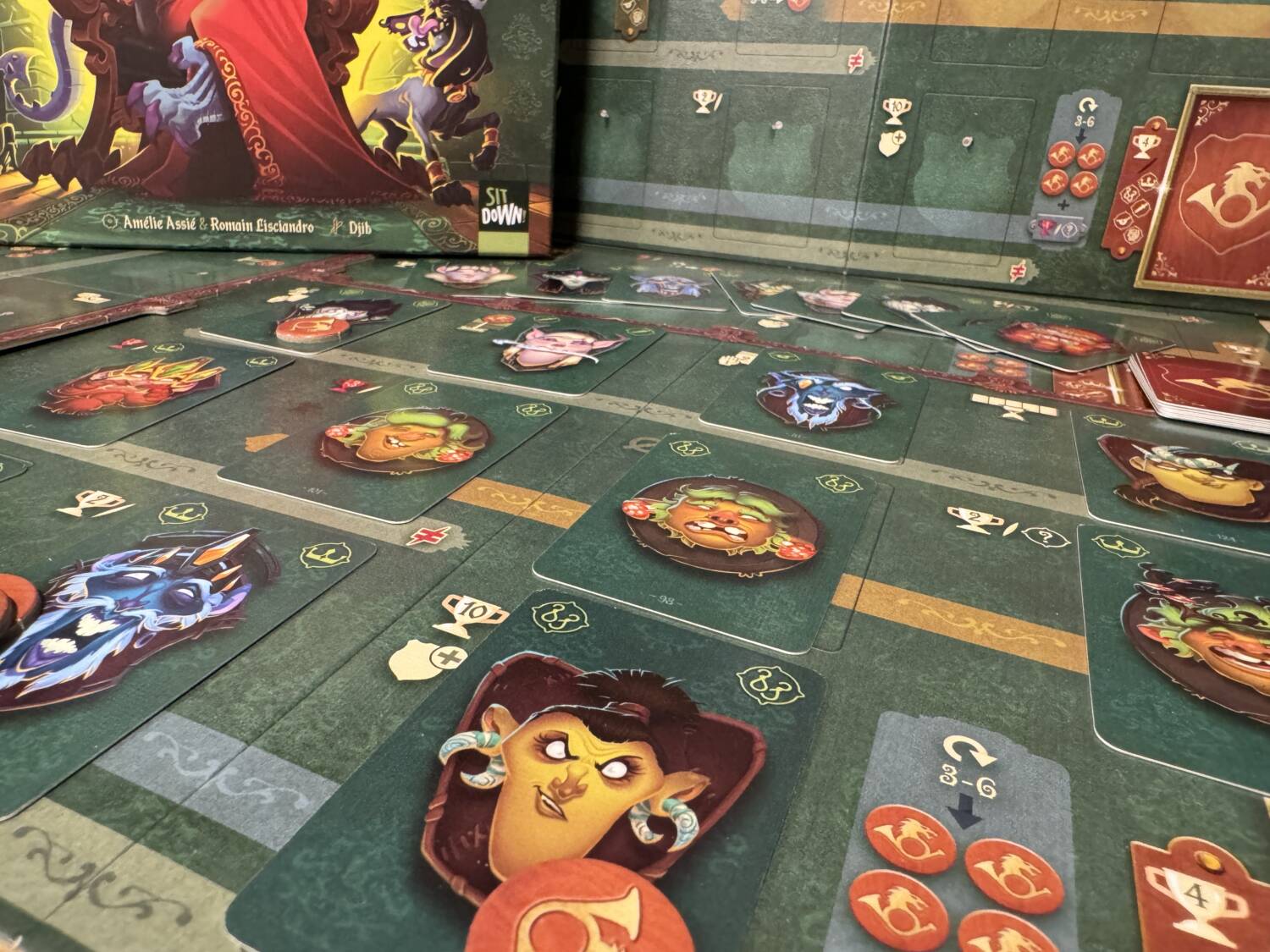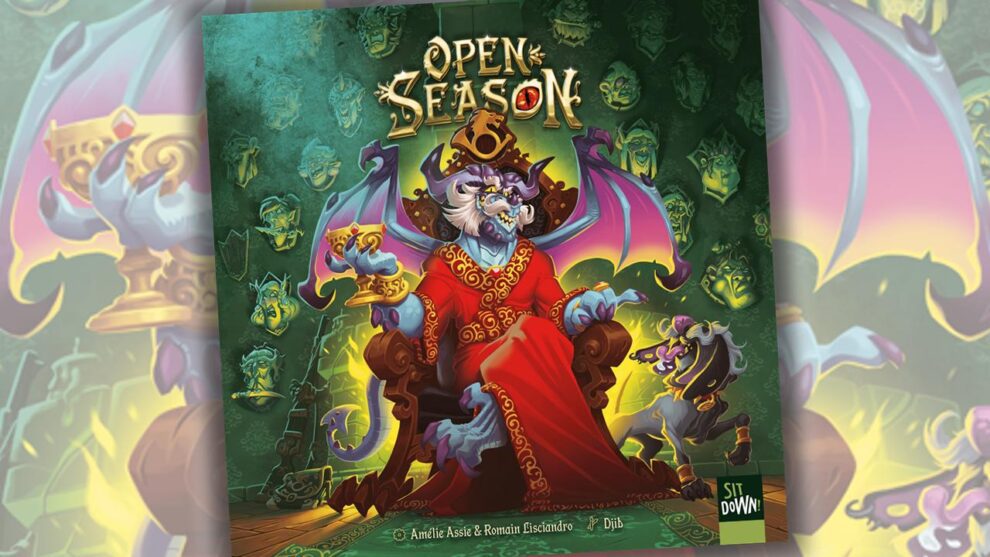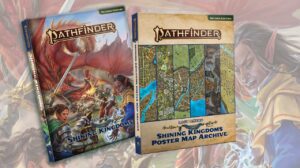Disclosure: Meeple Mountain received a free copy of this product in exchange for an honest, unbiased review. This review is not intended to be an endorsement.
There’s one trope in gaming that I feel is severely underutilized: flipping the script. Typically, games put you in the shoes of the valiant heroes to slay beasts, collect treasures, and save the day. That’s all well and good, but sometimes I want to play on the other side of the aisle and be the bad guy. Games like Evil Corp or Overboss immediately come to mind, offering a different perspective from the norm. When I saw Open Season for the first time, I was naturally drawn in simply on the premise of collecting heads from hapless heroes to put on my trophy room wall.
Open Season Overview
Gameplay in Open Season is very simple. Each turn starts with the Inn showing five potential People for the active player to take. Of these People, they’ll choose two, placing one onto an available space on their Wall and the other into their Stock. Seems straightforward, right?
Where the game gets interesting is that your Wall restricts cards from being played in certain spaces. Usually this comes in the form of a row disallowing another of a previously played type of People card from being played in that row. A portion of the middle row is an exception, where playing three of the same kind of People card will net you some bonus points.
After playing your two cards, the game’s sneaky little combo mechanic comes into play. If you had sent a card type to your Stock that matches a card in the first row, you’ll get to activate that space’s ability. This could be something like grabbing an extra card from the Inn to place in your Stock or stealing a card from another player’s Stock and adding it to your own. This, in turn, could activate another card in your top row so long as it hasn’t been activated that turn yet.
Yes, there is card-stealing and a take-that feeling to this game, but the faint of heart should not be afraid. If a card is taken from your Stock, you’ll get to replace it with one from the Inn. There’s actually a strategy around this where you might actually want a different card from the stock and you want to bank on the opponent stealing from you.
A scoring objective can be found on each space on the second and third rows of the Wall; over the course of the game you’ll be determining the scoring criteria for your personal Accolades. You might want to be collecting the most Dwarven cards or trying not to acquire Barbarians (lest you lose points). After everybody’s boards are filled at the conclusion of 11 rounds, the scores are tallied and the highest score is the winner.

Open Season Brings Things to a Head
At its core, Open Season is an optimization puzzle where you have plenty of options to play starting out. It’s one of those games where you have to remain very open to changing your strategy as you go along and pivoting based on your current progress. If you find yourself suddenly picking up a bunch of Wizards, then you may want to ensure you get a Wizard in one of the spaces that awards more points.
There is also an obvious advantage to playing at least one card in the top row early in order to enable more combos over the duration of the game. In every game that I’ve played, players would use one of their first two moves to either play in the space that would grant an extra card from the Inn or the space that would allow them to steal from another player’s Stock. The value is just too high to ignore those spaces in the early game.
At the same time, the game incentivizes play in certain areas of the Wall during specific rounds. For example, if you can manage to fill the bottom row within the first six turns, you’ll earn a whopping 4 Trophy markers in addition to a malus for whatever attribute you have the fewest of in your Accolades. Trophies are used for granting additional points to a specific space on your Wall and they also trigger top row actions during a round where they haven’t been activated before.
These incentives create a situation where there are benefits to playing in almost every space on the board at any given time, and I frequently found myself weighing the case for multiple placements each turn. If you tend to get into analysis paralysis situations frequently, this could cause you a bit of frustration.
One of the hardest aspects of Open Season is wrapping your mind around the scoring puzzle, and part of the difficulty only exists because of the card layout. There’s a symbol representing an attribute present in the upper left corner of each card. When you play a card in the bottom left, for example, the iconography reads like ‘1 Point for each attribute’, because the attribute directly follows the slash. However, there is a symbol representative of an attribute (a circle with a question mark) that would have to be used in that case. Our example actually reads as ‘1 Point for each card matching this People type’. It was definitely confusing on my first play.
There are two sides of the board which offer variability in the gameplay. Additionally, you can choose to play with Bonus tiles which are selected on an individual player basis and offer a unique effect if you fill up their corresponding column. This tends to perpetuate increased thinking time, but I found that I preferred games where each player had slightly different effects to use.

Open Season A Headfirst Kind of Puzzle
Despite my negatives towards the iconography, Open Season is a decent puzzle waiting to be solved. And I do mean that quite literally, as I feel like there is likely a most strategic path that you could figure out that would optimize the number of cards that you could get into your Accolades. Obviously this is also dependent on the cards that come up in the Inn, but the general consensus for me is that more Accolades equals more points.
It’s because of this that the base game (Horn side of the board) does feel very samey after about five plays, so it’s really nice to have options with the opposite side and the Expert/Bonus tiles. Even with those, I don’t see myself pulling Open Season off the shelf with much regularity, although it serves a role as game with light rules overhead and simple gameplay.
I guess what I’m saying is that in a game about heads, I wish the game had more legs.












